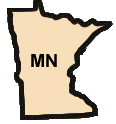On Eve of New Economic Forecast, Minnesota Prepares for Further Budget Strains
Democratic-controlled legislatures in the spotlight, facing largest budget shortfalls across the nation

A sluggish economy is forcing many states, including Minnesota, to address new budget gaps due to revenue that is falling shy of previous projections that had already forced most states to address significant budget deficits in the previous legislative session.
The Center on Budget and Policy Priorities report finds 35 states have already reported mid-year budget gaps, not including Minnesota.
Even before calculating the expected new gap in Minnesota’s state budget, the Gopher State has had to address the 16th largest per capita FY2010 budget shortfall in the nation this year – at $590 per resident – according to a Smart Politics analysis of budgetary and U.S. Census data.
Minnesota’s budget shortfall was the largest per capita in the Upper Midwest, with Wisconsin ranked at #17 nationally ($558 per capita), Iowa at #25 ($398), South Dakota at #48 ($40), and North Dakota one of just two states in the nation which has been deficit-free (along with Montana).
When examining the Gopher State’s shortfall as a percentage of its FY2010 budget (21.0 percent) Minnesota ranks in the middle of the pack (24th largest in the nation).
Overall, Western states are facing some of the largest budget shortfalls with Alaska ($1,872 per capita), California ($1,518) and Oregon ($1,107) ranked #1, #2, and #4 respectively. Hawaii (#8, $895) and Arizona (#10, $783) also rank among the Top 10 states with the largest FY2010 budget gaps.
And what political party is going to pay the price for these ongoing state budget crises?
Democrats have unified control of both legislative chambers in 18 of the Top 21 states with the largest budget shortfalls in the nation.
Alaska (#1, split control), Arizona (#10, unified GOP control), and Kansas (#14, unified GOP control) are the only states in the Top 21 in which Democrats do not control the upper and lower legislative chambers.
Moreover, Democrats did not inherit this budgetary crisis. The Democratic Party had unified control of both chambers in 17 of these 18 states in question prior to the 2008 election, with only the Delaware Senate flipping to the Democrats last November among these states.
Democrats have also controlled 13 of the governorships in these 21 states as these budgets were being created (and revisited).
Minnesota (and national) political observers will be watching to what extent Governor Tim Pawlenty takes a high profile in addressing the new budget gaps facing the Gopher State. Pawlenty’s anti-tax stance played out in a fierce public battle with the DFL leadership last Spring, culminating in both vetoes of tax bills and unilateral spending cuts through his authority to utilize unallotment in balancing the budget.
Largest Per Capita FY2010 State Budget Shortfalls
|
Rank
|
State
|
Legislative Control
|
Per Capita
|
|
1
|
Alaska
|
Split
|
$1,872.90
|
|
2
|
California
|
Democratic
|
$1,518.37
|
|
3
|
Connecticut
|
Democratic
|
$1,341.72
|
|
4
|
Oregon
|
Democratic
|
$1,107.89
|
|
5
|
Illinois
|
Democratic
|
$1,107.08
|
|
6
|
New York
|
Democratic
|
$1,080.04
|
|
7
|
New Jersey
|
Democratic
|
$1,020.16
|
|
8
|
Hawaii
|
Democratic
|
$895.07
|
|
9
|
Massachusetts
|
Democratic
|
$842.18
|
|
10
|
Arizona
|
GOP
|
$783.44
|
|
11
|
Washington
|
Democratic
|
$749.01
|
|
12
|
Maine
|
Democratic
|
$736.85
|
|
13
|
Rhode Island
|
Democratic
|
$707.47
|
|
14
|
Kansas
|
GOP
|
$641.60
|
|
15
|
Delaware
|
Democratic
|
$629.85
|
|
16
|
Minnesota
|
DFL
|
$590.34
|
|
17
|
Wisconsin
|
Democratic
|
$558.72
|
|
18
|
New Mexico
|
Democratic
|
$504.99
|
|
19
|
North Carolina
|
Democratic
|
$492.20
|
|
20
|
Maryland
|
Democratic
|
$474.18
|
|
21
|
Vermont
|
Democratic
|
$468.96
|
|
22
|
Virginia
|
Split
|
$449.42
|
|
23
|
Georgia
|
GOP
|
$448.43
|
|
24
|
Nevada
|
Democratic
|
$446.01
|
|
25
|
Iowa
|
Democratic
|
$398.68
|
|
26
|
Louisiana
|
Democratic
|
$390.23
|
|
27
|
Utah
|
GOP
|
$385.35
|
|
28
|
Pennsylvania
|
Split
|
$381.42
|
|
29
|
Idaho
|
GOP
|
$370.40
|
|
30
|
Alabama
|
Democratic
|
$348.10
|
|
31
|
Colorado
|
Democratic
|
$331.16
|
|
32
|
Florida
|
GOP
|
$311.66
|
|
33
|
Ohio
|
Split
|
$310.98
|
|
34
|
Kentucky
|
Split
|
$281.35
|
|
35
|
Oklahoma
|
GOP
|
$273.70
|
|
36
|
Michigan
|
Split
|
$268.49
|
|
37
|
Missouri
|
GOP
|
$253.29
|
|
38
|
Mississippi
|
Democratic
|
$220.43
|
|
39
|
Indiana
|
Split
|
$219.02
|
|
40
|
South Carolina
|
GOP
|
$208.24
|
|
41
|
New Hampshire
|
Democratic
|
$180.43
|
|
42
|
Tennessee
|
GOP
|
$176.54
|
|
43
|
Nebraska
|
Non-partisan
|
$172.41
|
|
44
|
West Virginia
|
Democratic
|
$155.26
|
|
45
|
Texas
|
GOP
|
$141.99
|
|
46
|
Arkansas
|
Democratic
|
$88.00
|
|
47
|
Wyoming
|
GOP
|
$61.55
|
|
48
|
South Dakota
|
GOP
|
$40.69
|
|
49
|
Montana
|
Split
|
$0.00
|
|
49
|
North Dakota
|
GOP
|
$0.00
|
Note: Per capita data compiled by Smart Politics from Center on Budget and Policy Priorities budget data (data through November 20, 2009) and U.S. Census Bureau 2010 population estimates. Budget data includes both announced budget gaps as well as initial (previously addressed) shortfalls.
Follow Smart Politics on Twitter.
